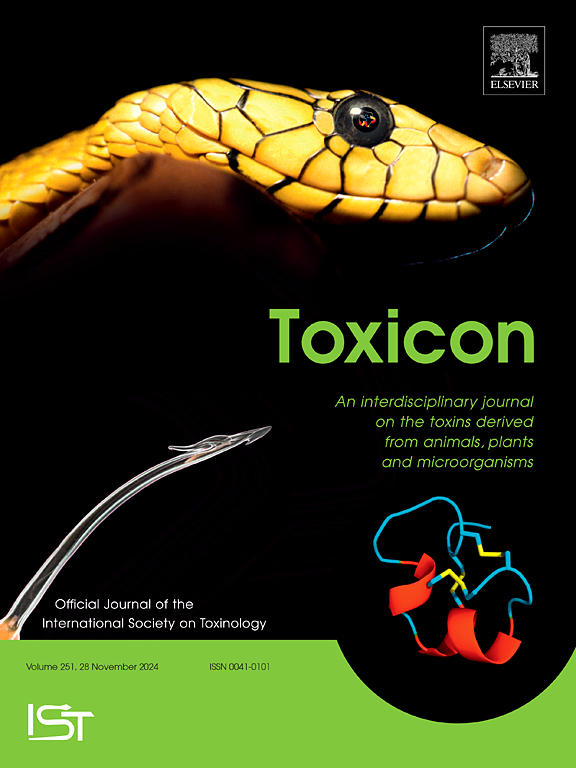在anatoxin-a生物合成簇中具有基因变异的Microcoleus菌株的共存可以解释在淡水底栖垫中观察到的不同毒素谱。
IF 2.6
4区 医学
Q2 PHARMACOLOGY & PHARMACY
引用次数: 0
摘要
在以微藻为主的底栖垫中可能出现不同的安纳托毒素谱。来自二氢同源阿那托毒素a产生菌的宏基因组数据显示,两种共同发生的微结肠菌菌株在阿那托毒素生物合成基因簇中存在差异。一个簇含有anaK (f420依赖的氧化还原酶),类似于二氢安纳毒素a产生菌株的同源物。第二种含有长anaG(聚酮合酶),以前与同源曲毒素a有关。两种菌株都不能单独解释所观察到的毒素分布,这表明菌株的相互作用有助于底栖垫中二氢同源藻毒素-a的产生。本文章由计算机程序翻译,如有差异,请以英文原文为准。
The co-existence of Microcoleus strains with gene variations in the anatoxin-a biosynthesis cluster can explain the different toxin profiles observed in freshwater benthic mats
Distinct anatoxin profiles can occur in Microcoleus-dominated benthic mats. Metagenomic data from a dihydrohomoanatoxin-a-producing mat revealed two co-occurring Microcoleus strains with variations in the anatoxin biosynthesis gene cluster. One cluster contained an anaK (F420-dependent oxidoreductase) similar to homologs from dihydroanatoxin-a-producing strains. The second contained the long anaG (polyketide-synthase) previously associated with homoanatoxin-a. Neither strain alone explained the observed toxin profile, suggesting that strain interaction contributes to the production of dihydrohomoanatoxin-a within benthic mats.
求助全文
通过发布文献求助,成功后即可免费获取论文全文。
去求助
来源期刊

Toxicon
医学-毒理学
CiteScore
4.80
自引率
10.70%
发文量
358
审稿时长
68 days
期刊介绍:
Toxicon has an open access mirror Toxicon: X, sharing the same aims and scope, editorial team, submission system and rigorous peer review. An introductory offer Toxicon: X - full waiver of the Open Access fee.
Toxicon''s "aims and scope" are to publish:
-articles containing the results of original research on problems related to toxins derived from animals, plants and microorganisms
-papers on novel findings related to the chemical, pharmacological, toxicological, and immunological properties of natural toxins
-molecular biological studies of toxins and other genes from poisonous and venomous organisms that advance understanding of the role or function of toxins
-clinical observations on poisoning and envenoming where a new therapeutic principle has been proposed or a decidedly superior clinical result has been obtained.
-material on the use of toxins as tools in studying biological processes and material on subjects related to venom and antivenom problems.
-articles on the translational application of toxins, for example as drugs and insecticides
-epidemiological studies on envenoming or poisoning, so long as they highlight a previously unrecognised medical problem or provide insight into the prevention or medical treatment of envenoming or poisoning. Retrospective surveys of hospital records, especially those lacking species identification, will not be considered for publication. Properly designed prospective community-based surveys are strongly encouraged.
-articles describing well-known activities of venoms, such as antibacterial, anticancer, and analgesic activities of arachnid venoms, without any attempt to define the mechanism of action or purify the active component, will not be considered for publication in Toxicon.
-review articles on problems related to toxinology.
To encourage the exchange of ideas, sections of the journal may be devoted to Short Communications, Letters to the Editor and activities of the affiliated societies.
 求助内容:
求助内容: 应助结果提醒方式:
应助结果提醒方式:


